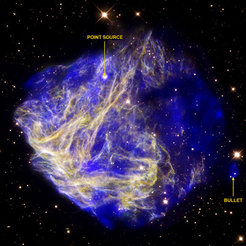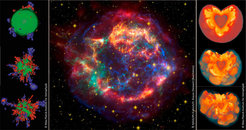
3D Long-time Supernova and Remnant Modeling
After the explosion of a massive star as a supernova the stellar material does not become invisible. While the core of the progenitor can either collapse to a black hole or form a neutron star, the outer stellar layers are blown away from the star and can be observed as a supernova remnant (SNR) up to tens of thousands of years (Fig.1). The spatial and velocity distribution of the ejected material depends sensitively on the precise explosion mechanism because of the involved hydrodynamical instabilities, and it may be changed in the course of the expansion due to interaction with the matter of the outer shells of the progenitor, the progenitor wind and with the interstellar matter.

Understanding of how the structure of the SNR develops and how it may change its shape and matter distribution is essential to get insights into the explosion mechanism of the supernova and the structure of the progenitor star. For this purpose we will perform three dimensional simulations starting after the onset of the explosion, follow the breakout of the supernova shock wave from the progenitor star and evolve the system numerically for decades, centuries and even millennia (Fig.2). The conditions during the onset of the explosion will be obtained in the sub-project 3D explosion modeling by sophisticated 3D numerical simulations including neutrino transport. First results of the SNR evolution show that the metal-rich ejecta still carry fingerprints of initial asymmetries for times beyond the breakout from the progenitor, but the final metal distribution is massively affected by the detailed progenitor structure.

During the later stages of the evolution of the remnant also the heating due to radioactive decay of the freshly synthesized nuclei can become important in shaping the structure of the ejecta. Other effects like the energy losses due to radiation and partial ionization of the ejecta may play an important role, too. These new physical ingredients are included in the numerical code Prometheus as part of this project. Fortunately, there exists already a wealth of high-quality observations of nearby SNRs like SN1987A, Cas A or the Crab. Our final aim is the use of the observational data for these objects, which are available in different wave-length bands and have not been compared to sophisticated 3D simulations yet, to test the results of our simulations. This comparison will shed light onto the detailed explosion mechanism and the progenitor structure just before the explosion (Fig.3).

Not only the ejected material but also the compact remnants, the neutron stars and black holes, are very interesting astrophysical objects. Nowhere else can matter be found under such extreme conditions as in neutron stars: the pressure and density exceed those of atomic nuclei, gravity is so strong that general relativistic effects become important and they possess the strongest magnetic fields known in the universe. The neutron stars interact with their surroundings by powering pulsar wind nebulae inside SNRs or even contribute to the energy output of gamma-ray bursts. In general, the energy output of the compact remnant at very early times of their existence can also influence the shape and matter distribution of the gaseous remnant. Our knowledge about neutron star interiors is still very rudimentary and it is extremely difficult to obtain information about the physics inside of these exotic objects. One possibility to learn more about neutron star structure is to analyze their oscillation spectrum similar to what seismologists do for the earth or the sun. Fortunately, observers could detect some frequencies during giant flares of the most strongly magnetized neutron stars (magnetars, Fig. 1). We could identify these frequencies with magneto-elastic oscillations of the neutron star in general (Highlight February 2013). As a first constraint on the state of the matter we found that the interior of the neutron star is probably in a superfluid state (Highlight January 2014). However, the current models need to be refined and extended to include also a viable mechanism that can modulate the emission at the observed frequencies.


